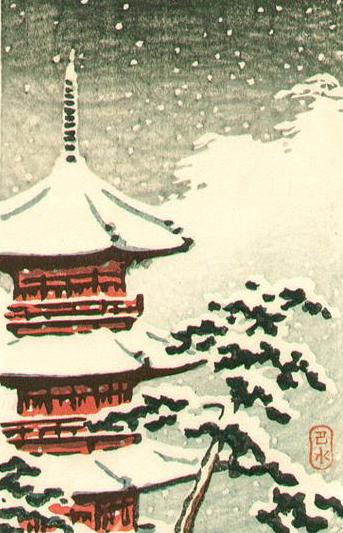Japan art in the snow: Kawase Hasui (1883-1957)
Lee Jay Walker
Modern Tokyo Times

The Japanese artist Kawase Hasui (1883-1957) belongs to the world of Shin-Hanga (New Prints). Throughout his life, he witnessed the dramatic changes that engulfed Japan. However, when viewing his art, you can still feel a connection with the past that provides comfort.
These art pieces by Hasui concern the snow-filled landscape. In these images, the serenity of Buddhism and Shintoism provides another delightful angle to the art of Hasui. Therefore, with the faithful praying – while the snow gently builds all around and provides lovely backdrops – the fusion of faith and nature is in perfect alignment for the viewer of Hasui’s art.

The Sompo Museum says, “Hasui was inspired by breezes and spent his days traveling with the sun, clouds, and rain, painting the scenery of all four seasons of Japan. This was also a journey to seek the scenery of old times. One of the key supporters of woodblock production was Shozaburo Watanabe, a woodblock print publisher and leader of the shin-hanga (new prints) movement. Their strong desire to create something special lead them to strive for woodblock prints that could also be appreciated overseas.”
Hasui fulfilled his dream when he was 26 after the failure of the business he was involved in collapsed. Initially, he studied art under Okada Saburōsuke. However, in time he would finally study under Kaburagi Kiyotaka.

The Museum of Art (MOA) says, “Kawase Hasui (1883–1957) initially studied painting under Kaburagi Kiyotaka, but sensational landscape woodcuts by Ito Shinsui changed the course of his career forever, to become a painter specializing in woodblock designs.”
Hasui is widely known in Japan because the gentle nature of his art is most appealing.

Modern Tokyo News is part of the Modern Tokyo Times group
DONATIONS to SUPPORT MODERN TOKYO TIMES – please pay PayPal and DONATE to sawakoart@gmail.com
http://moderntokyotimes.com Modern Tokyo Times – International News and Japan News
https://www.pinterest.co.uk/moderntokyotimes/ Modern Tokyo Times is now on PINTEREST
http://sawakoart.com – Sawako Utsumi personal website and Modern Tokyo Times artist
https://moderntokyonews.com Modern Tokyo News – Tokyo News and International News
PLEASE JOIN ON TWITTER
https://twitter.com/MTT_News Modern Tokyo Times
https://www.facebook.com/moderntokyotimes/ Facebook